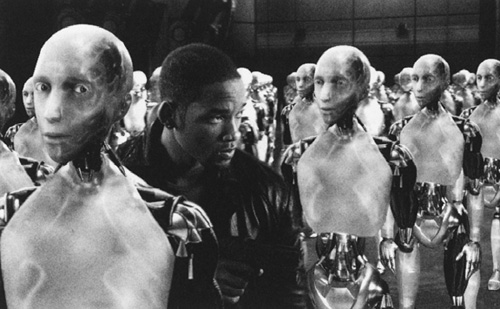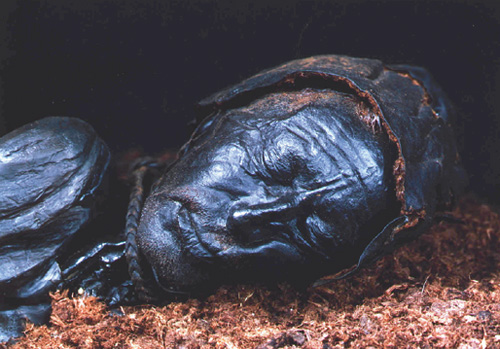Short takes on three books
By David Schneider, Fenella Saunders, Anna Lena Phillips
Hollywood Science: Movies, Science, and the End of the World, Transport Design: A Travel History and Skin: A Natural History
Hollywood Science: Movies, Science, and the End of the World, Transport Design: A Travel History and Skin: A Natural History

DOI: 10.1511/2008.70.172
HOLLYWOOD SCIENCE: Movies, Science and the End of the World. Sidney Perkowitz. Columbia University Press, $24.95.

From Hollywood Science: Movies, Science, and the End of the World, by Sidney Perkowitz.
Physicist Sidney Perkowitz's latest book is a lighthearted survey of factual and fictional science in the movies. Hollywood Science should appeal to scientists, because its author clearly appreciates the difference between bending real science (to stimulate the imagination or simply out of cinematic necessity) and butchering it. Perkowitz bestows "Golden Eagle Awards" on select films that do the former and "Golden Turkeys" on some that do the latter.
Like any physicist trained to seek order in a complex, chaotic universe, Perkowitz structures his analysis logically, grouping films according to common themes: "Genes and Germs Gone Bad," for example, and "The Computers Take Over," in which he describes, among other films, I, Robot (2004, above). His sardonic style makes some of his capsule summaries (especially of the bad films) a hoot. And his synopses of the better ones, particularly such classics as The Day the Earth Stood Still (1951), Dr. Strangelove (1964) and GATTACA (1997), will remind those who've seen them how good they indeed were.
Although Perkowitz covers a large number of movies, there are some surprising gaps. For example, his commentary on science fiction with literary roots misses Forbidden Planet (an otherworldly version of The Tempest, released in 1956). And although he discusses at length some documentary-like movies, he fails to mention Apollo 13 (1995)—a Golden Eagle if ever there was one.
Hollywood Science is great fun. It brings less-well-known films to the reader's attention—I'm putting Panic in the Streets (1950) on my to-rent list—and delves into the serious issues of how such films serve to educate the public and to inspire the scientific enterprise. I give it two thumbs up!—David Schneider
TRANSPORT DESIGN: A Travel History. Gregory Votolato. Reaktion Books, $35.
Compared with the pressing issue of energy use in transit technology, the matter of how the structures and interiors of vehicles are designed can seem trivial. Gregory Votolato's Transport Design aims to correct this impression. In three sections, Land, Water and Air, the book covers technological innovations that have contributed to passenger comfort and safety on a wide range of conveyances, from horse-drawn carriages, dugout canoes and dirigibles to subway cars, ocean liners and Boeing 747s.

From Transport Design: A Travel History, by Gregory Votolato.
Popular song lyrics are sprinkled throughout, providing clues to people's changing perceptions of the trolley cars, riverboats and airplanes they rode in. Photographs of the interiors of early trains will make you want to shuffle off to Buffalo, and copy for an advertisement for a 1930s-era Chrysler (left) serves as a reminder that riding around in an automobile was once considered radical.
Votolato lists four factors that influence the development of transit infrastructure and vehicle design—privacy, independence, economy and image—and shows these concerns at work. In addition, readers may learn more than they wanted to know about the upholstery fabrics used in everything from the London Underground to the latest aircraft. This focus perhaps explains why the bicycle, a crucial means of transport since John Kemp Starley invented the safety bicycle in 1888, gets short shrift—there's not much you can upholster on a bike.
But at the very end of the book, in a vision that will please cyclists, Votolato imagines people riding bubble-topped bikes over cycle superhighways in futuristic cities connected by magnetic-levitation train systems. Ticket for the maglev? Sure, I'll take that ride.—Anna Lena Phillips
SKIN: A Natural History. Nina G. Jablonski. University of California Press, $24.95.
Skin covers us, protects us, cools us and identifies us—stripped of it, we're all but unrecognizable. As Nina G. Jablonski explains in Skin, it also differentiates us from other primates: One of the ways in which humans differ in genetic makeup from chimpanzees, our closest relatives, is in the genes that code for the proteins that constitute the keratin-rich layer of our skin.

From Skin: A Natural History, by Nina G. Jablonski.
 Other topics Jablonski covers include how the dermis and epidermis function, why humans are sweaty and hairless, how skin responds to exposure to sunlight and how it is pigmented, its function as an organ of touch, how it betrays our feelings, how it ages, the prospects for artificial skin, and rare occurrences of the preservation of skin—by cold, acidic peat bogs, for example, as occurred with Tollund Man (right), who lived on the Jutland Peninsula in the 4th century B.C.
Other topics Jablonski covers include how the dermis and epidermis function, why humans are sweaty and hairless, how skin responds to exposure to sunlight and how it is pigmented, its function as an organ of touch, how it betrays our feelings, how it ages, the prospects for artificial skin, and rare occurrences of the preservation of skin—by cold, acidic peat bogs, for example, as occurred with Tollund Man (right), who lived on the Jutland Peninsula in the 4th century B.C.
Readers learn that melanin has the ability to mop up free radicals, and they are reminded that ultraviolet light, although it can damage DNA, is vital in the production of vitamin D. Jablonski theorizes here that women worldwide tend to have lighter skin than their mates because that allows them to synthesize more vitamin D during pregnancy, enhancing calcium uptake and improving the bone health of the fetus.
Much of the book covers ways that people use their skin to decorate and re-create themselves—from makeup to tattoos. Jablonski endorses people's right to turn their skin into a billboard, saying that self-expression of this sort is something that separates us from other animals.—Fenella Saunders
Click "American Scientist" to access home page
American Scientist Comments and Discussion
To discuss our articles or comment on them, please share them and tag American Scientist on social media platforms. Here are links to our profiles on Twitter, Facebook, and LinkedIn.
If we re-share your post, we will moderate comments/discussion following our comments policy.